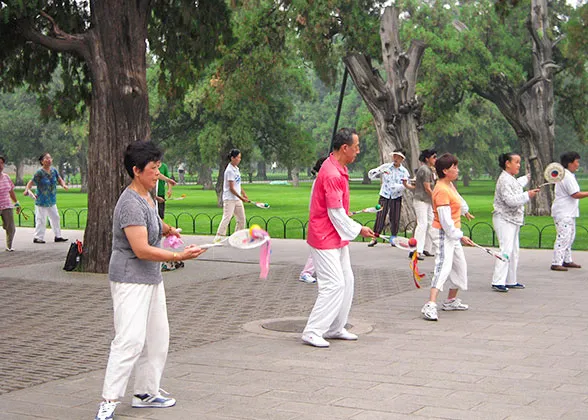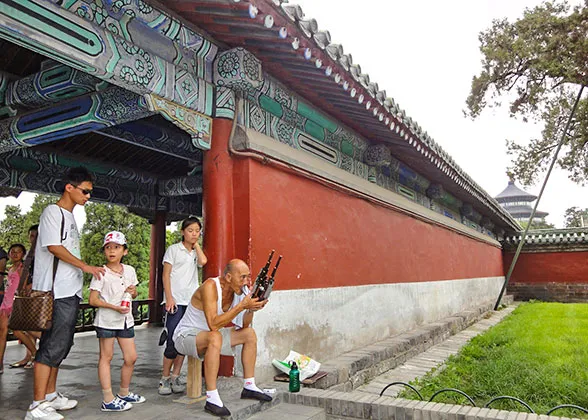Top 10 Temple of Heaven Facts You Should Know
Basic Facts of the Temple of Heaven:
![]() Chinese Name: 天坛
Chinese Name: 天坛![]() Chinese Pinyin: Tian Tan
Chinese Pinyin: Tian Tan![]() Location: Dongcheng District, Beijing.
Location: Dongcheng District, Beijing.![]() Area: 273 hectares (675 acres)
Area: 273 hectares (675 acres)![]() Initiator: Emperor Yongle of Ming Dynasty
Initiator: Emperor Yongle of Ming Dynasty![]() Construction Period: 1420 in the Ming Dynasty
Construction Period: 1420 in the Ming Dynasty ![]() Construction Application: to held annual Heaven Worship Ceremony.
Construction Application: to held annual Heaven Worship Ceremony.
1. It Is the Largest Existing Architecture Group For Heaven Worship in the World.
The area of the Temple of Heaven is up to about 273 hectares (675 acres), making it the largest existing architecture group for heaven worshiping in the world.
2. It Is List on the World Heritage List.
The Temple of Heaven, with its outstanding historical value, scientific value, unique artistic value and profound cultural connotation, was listed on the World Heritage List by UNESCO in 1988.
3. It Turns to A Park for Morning Exercise Among Locals.
Although it was used as a place for worshiping the heaven by 22 emperors in ancient times, it is not turned into a public park, where a large number of local people do morning exercises. If you go there early, around 08:00 to 10:00 in the morning, you will see many people playing Tai Chi, practising Chinese Kung Fu or singing Peking Opera. You will also see various birds, because some old native of Beijing like to take a walk with their birds. To some extense, Temple of Heaven is the best place in the morning to get close to Beijingers.
|
|
4. It Is 4 Times the Size of the Forbidden City.
As we mentioned above, the scale of Temple of Heaven Park is very large, but few people know that the area of it is four times larger than the Forbidden City. The Forbidden City covers an area of 72 hectares (178 acres), while the Temple of Heaven covers 273 hectares (675 acres), namely accounting for just over a quarter of the Temple of Heaven.
5. Royal Building Not Built on the Central Axis of Beijing
Almost all important ancient buildings in Beijing were built on the axis of Beijing city expect for the Temple of Heaven, which is located a little east of the axis. Do you wonder why such an essential architecture is not on the central axis? The answer is that this location is chosen based on the orientation of the sun. According to the Books of Changes, the southeast of the Forbidden City receives the strongest sunlight all year around, so it is the best place for building Temple of Heaven.
6. It Has 2 'Temples', Inner And Outer.
The Temple of Heaven mainly consists of the inner temple and outer temple which center Circular Mound Altar and Hall of Prayer for Good Harvests respectively. Circular Mound Altar is for heaven worship while Good Harvest Temple is for the praying for a rich harvest.
7. The Number of Stone Slabs and Steps in Circular Mound Altar is 9 or Multiple of 9
The number 9 has close relationship with Circular Mound Altar. Starting from the central stone or the Heavenly Center Stone of the Circular Mound Altar, the number of stone slabs in the first lap is nine and the second lap is eighteen. Nine is the largest number in the singular and Chinese people use nine to present the limitless of the sky.
8. There are 8 Major Buildings in Temple of Heaven.
![]() Circular Mound Altar, “圜丘” (yuan qiu), is the site emperor held the winter solstice worship ceremony.
Circular Mound Altar, “圜丘” (yuan qiu), is the site emperor held the winter solstice worship ceremony.![]() Imperial Vault of Heaven, “皇穹宇” (huang qiong yu) lies in the north of the Circular Mound Altar, is the place where memorial tablets of gods are enshrined.
Imperial Vault of Heaven, “皇穹宇” (huang qiong yu) lies in the north of the Circular Mound Altar, is the place where memorial tablets of gods are enshrined.![]() Altar of Prayer for Good Harvest, “祈年殿” (qi nian dian ). Emperor worshiped for a rich harvest in the first lunar month here.
Altar of Prayer for Good Harvest, “祈年殿” (qi nian dian ). Emperor worshiped for a rich harvest in the first lunar month here.![]() The Hall of Imperial Zenith, “皇乾殿” (huang qian dian ) . The memorial tablets of the ancestors of the emperor and gods are enshrined here.
The Hall of Imperial Zenith, “皇乾殿” (huang qian dian ) . The memorial tablets of the ancestors of the emperor and gods are enshrined here.![]() Palace of Abstinence, “斋宫” (zhai gong). Emperors fasted here before the heaven worship ceremony started.
Palace of Abstinence, “斋宫” (zhai gong). Emperors fasted here before the heaven worship ceremony started.![]() Kitchen for Sacrifice, “南神厨院” (nan shen chu yuan). Sacred offerings were cooked here.
Kitchen for Sacrifice, “南神厨院” (nan shen chu yuan). Sacred offerings were cooked here.![]() Divine Music Administration, “神乐署” (shen yue shu), was the place where rituals and music are played.
Divine Music Administration, “神乐署” (shen yue shu), was the place where rituals and music are played.![]() Imperial Walkway Bridge or Danbi Bridge, “丹陛桥” ( dan bi qiao), is the axis that connects the inner temple and the outer temple together.
Imperial Walkway Bridge or Danbi Bridge, “丹陛桥” ( dan bi qiao), is the axis that connects the inner temple and the outer temple together.
9. The Hall of Prayer for Good Harvests is the Most Photogenic Architecture
Most pictures you find online are the photos of Hall of Prayer for Good Harvests. As the most represetative hall among all, it is the tallest and the most imposing building, with diameter up to 33 meters (36 yards) and 38 meters (42 yards) in height. Thus, travelers are keen to have photos photos with it a photo of it.
10. Echo Wall is Children’s Favorite
Echo Wall is about 4 meters (4.4 yards) high, 1 meter (1.1 yards) thick, and 193 meters (211 yards) long. The wall is extremely smooth and tidy, making it can reflect sound waves in an accurate manner. If two people talk against the wall in the east and west of the hall, no matter how low the voice is, they can hear each other clearly.

